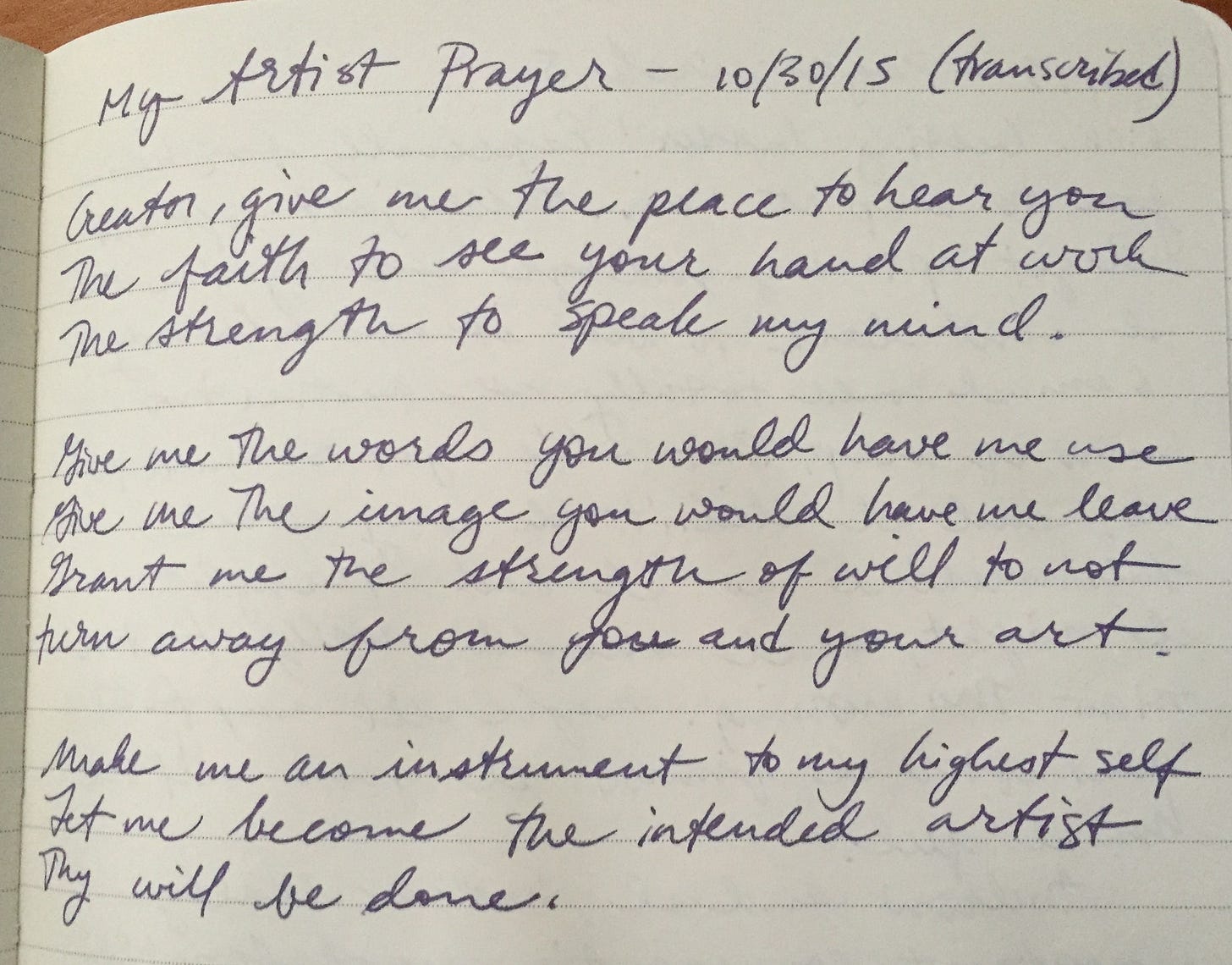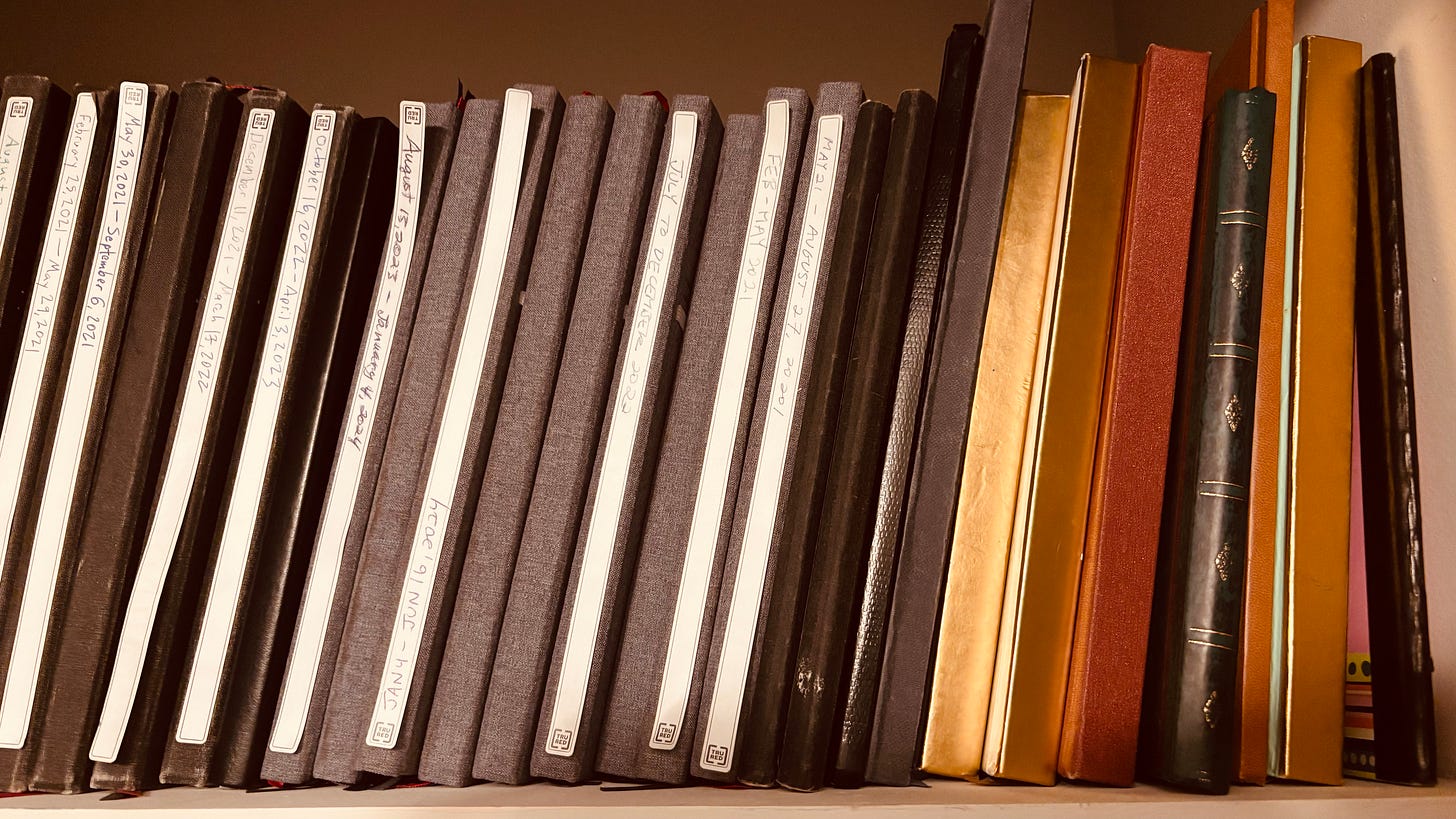I started writing morning pages in October of 2015.
I was nine months into an unexpectedly harrowing abortion recovery, which had been both physically gruesome and emotionally exhausting.
I caught up with a friend I’d known in high school (we were both regular performers in our school plays and a capella group), and she recommended The Artist Way by Julia Cameron.
“What is it?” I asked, curious.
Her explanation: “It helps you connect to the creativity that’s already inside you.”
Something in my body lit up.
As soon as I got home, I ordered the book online, and the following Sunday, started the “course.” Always thinking a few steps too far into the future, I calculated forward, to see when I should expect to finish if I kept to the suggested 12-week schedule. My completion date was my 30th birthday. I sat for a moment, taking this in, my first awareness of what Julia would call “synchronicity.”
The Artist Way protocol is fairly straightforward: i) write three long-hand pages a day first thing in the morning on just about anything, ii) take your inner artist on weekly ‘dates’ by yourself to do fun artist things and iii) complete the weekly writing and experience exercises outlined in the 12-week self-guided learning experience. I found artist dates a revelation because I’d never thought of “my artist” as a person who needed that kind of treatment. And the writing exercises helped me dig into issues I hadn’t explored. But at the end of 12 weeks, they’re over, whereas the daily habit of morning pages can linger longer after The Artist Way “course” is complete.
I have heard that many writers struggle with or resist the prescribed discipline of daily writing, but for me, it was medicine I hadn’t known I needed so badly until I started taking it. The habit formed seemingly overnight.
In those early days, I woke up 30 minutes earlier than usual, as Julia recommended, and sat by the large picture window in the 8th-floor one-bedroom DC apartment I shared at the time with my first husband.
I started in a half-full notebook I thought might be wasted if it wasn’t used, but within a few weeks, it was full. I realized I’d been foolish not to appreciate how many pages three pages a day every day for 12 weeks adds up to (252). Over the next two years, I often looked for interesting notebooks while traveling, filling a collection of journals that range in size, color, texture, and length. By 2017, I’d realized that a “standard” 5x8.25” notebook wasn’t big enough for much my brain had to say each day, so I upgraded to large 8x10 notebooks I could reliably find at Staples, dropping down to two pages a day when circumstances demanded it. When supply chains shifted in 2021, I switched to the Staples TRU RED Large Mastery journal, which I’ve now been using for most of the last four years.
For pens, for years I favored the Pilot Pro 7, but when I briefly moved to Europe in 2019 disposable fountain pens were easier to find. Then I remembered an actual fountain pen—Waterman Carène my stepmother had given me, which I’d rarely used. I was exchanging weekly letters by mail with a love interest, and I liked the capital-R Romantic idea of letters written in fountain pen, which quickly made its way to my pages notebook. Six years later, I’m still using the same pen, almost finished with my second bottle of Waterman Serenity Blue.
When I first started writing back in 2015, much of the substance of my daily pages was the dross of years of stalled creativity. Julia Cameron’s affirmations helped fortify me against long-held doubts about my creative potential, but there was still plenty of censorious crap to work through. As the months went by, it became a helpful substitute for therapy, a place where I could cast off my doubts, fears, and anxieties, and feel a semblance of control over my psychic space.
As time wore on, I settled into a pattern—summarizing the events of the day before and clarifying the opportunities of the day ahead. To people to whom I recommend the Artist Way and morning pages, I often call this “cleaning the windshield”—getting rid of the shit that doesn’t matter so you can focus on the stuff that does. When I was preparing to walk the Camino Frances pregnant in March of 2022, I spent the months leading up to it doing “Camino math,” creative divisions of 500 miles over 40 days that could accommodate the logistical limitations of the path and my increasingly pregnant body. Ultimately, these calculations were completely useless, but it helped allay my anxieties to have somewhere to put them. A kind of Camino math still crops up in my pages periodically—when I’m worried about money or how to structure my time. Having a place where I can get my head straight about stupid things I’m spending mental energy worrying about lets me set those things aside more easily so I can focus my mental energy on the things that actually matter.
I’ve come to think of this daily practice as keeping my own history and a place where I sometimes catch poems, or essays (like this one) working their way through my subconscious. Some days the words come fast and easy, others slow and difficult. Perhaps miraculously, I estimate I’ve missed less than 30 days over the course of the last ten years. Through divorce, the 500 miles of Camino, and the challenging early days of new motherhood, I kept writing at least one page a day. Even when I was working 80-hour weeks on the Clinton campaign in 2016, I still made time at the crack of dawn to scrawl out one page in a small journal. When I was falling out of love with my first husband and in love with the man who would become my second, my pages show my emotional evolution far more honestly than any words I ever uttered aloud.
(When my second husband and I first met, I recommended the Artist Way to him. Later, we would read our pages aloud to one another, marveling at how the depth of our emotional relationship developed from our individual reflections.)
When I need to go back to a moment in time, to remember the circumstances of an event, or the specifics of where, when, or how it happened, the trail of breadcrumbs in my morning pages leads me back to what happened, and who I was in that moment.
I know that a world rife with too many things doesn’t easily support every human carrying with them a collection of more than a hundred notebooks filled with memories over the course of a life. (Those who have embraced 750 Words a Day have discovered a more adaptable solution.) Still, almost to a person, those I know who have adopted morning pages have reported it to be a life-changing practice. And if all it takes is the right pen and the right notebook, used diligently and daily, maybe the world would be a better place for it.
Join Us
Thinking about writing for CoAuthored? Join us for our May Mindmeld on Monday May 12 at 3:30pm ET to hear what’s moving in the universe and find your inspiration.
Interested? Let us know in the comments and we’ll send you the link.
This Week in the Fosterverse
Seasons of Life by Nicholas Goodey
My Joy List by Syd Connolly
The Winter Fugitive, Part I by Edward Garrahy
Findus Crispy Pancakes by Cams Campbell
Creating my version of "Portrait of an Artist: Jason Jägel" by Derrick Chiu
i found a way to make this easy by Jason Shen
My reverse planning process by Stella Inabo
What Is Lyricism? Part One. by Joshua Doležal
Can You Taste It? by River Kenna
From Timber Cove by Melody Song
Destabilization & the Frequency of Values by River Kenna
What is Truth? by Ann Gauger
261: Making Gut Calls by Jason Shen
Learning to stay by Asha Sanaker
The Wicked Willow That Haunted My Brother by Rick Lewis
50! by Russell Smith
For this introvert, that's really quite remarkable. by Cams Campbell
Practicing Grounding Through Fiber Arts and Crafts by Kathryn Vercillo
for those considering a change by Jason Shen
May the Fourth Be With You by Alicia Bonner




Brave and beautiful. Write on, Alicia!
I started doing morning pages during covid and have kept up with it ever since. It’s one of the best habits I’ve ever developed. So much of this resonates, thanks for writing!